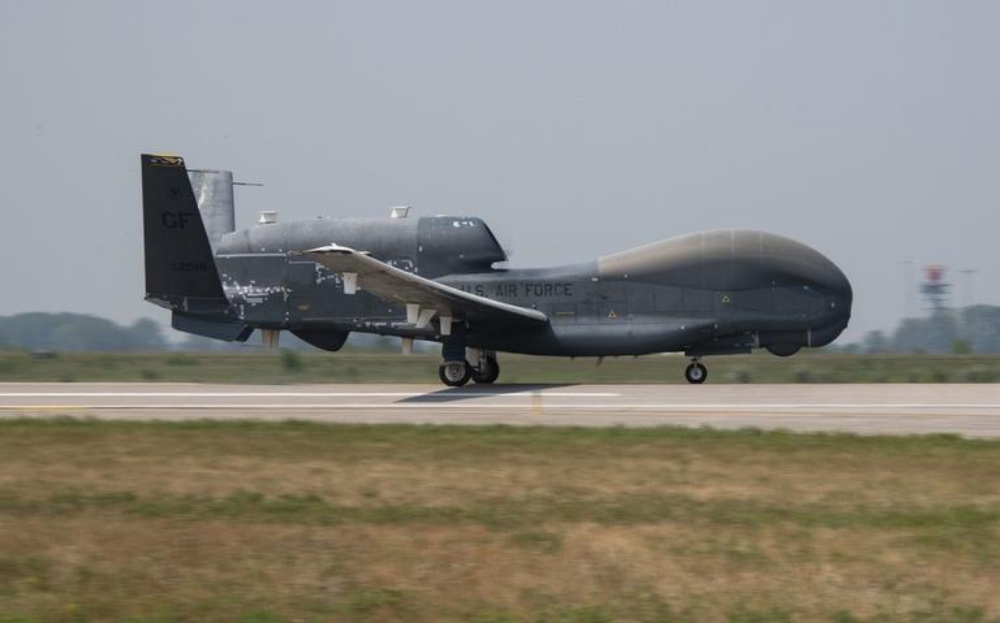
Airmen from the 319th Civil Engineering Squadron perform a water salute for the EQ-4 Global Hawk in honor of its final landing at Grand Forks Air Force Base on July 29. 2021
Lea Greene, chief of public affairs at Grand Forks Air Force Base, and Bruce Gjovig said the line of retired unmanned aircraft, called “Block 20” Global Hawks, will be used to conduct hypersonic testing over the Pacific Ocean.
Gjovig serves on the Grand Forks Base Retention Impact Committee (BRIC), and has played a key role on initiatives such as the Grand Sky unmanned aerial systems research park and Beyond Visual Line of Sight (BVLOS) drone flight.
Four decommissioned Global Hawk drones will make the short trip from Grand Forks Air Force Base to Northrop Grumman’s Grand Sky location, where they will be repurposed into a testing platform for new hypersonic technology, and will again take to the sky.
Lea Greene, chief of public affairs at Grand Forks Air Force Base, and Bruce Gjovig said the line of retired unmanned aircraft, called “Block 20” Global Hawks, will be used to conduct hypersonic testing over the Pacific Ocean. Gjovig serves on the Grand Forks Base Retention Impact Committee (BRIC), and has played a key role on initiatives such as the Grand Sky unmanned aerial systems research park and Beyond Visual Line of Sight (BVLOS) drone flight.
“It’s very exciting,” Gjovig said. “Hypersonics is a whole new division of capability that the military is developing. It’s just terrific to have our base, and in this case Grand Sky, really involved in hypersonics testing.”
Northrop officials issued a brief statement on the retired Block 20s, citing the need to reach a formal agreement with a government customer. Company officials said they will discuss the plan at a later date.
“The Global Hawk Block 20s have performed extremely well protecting the interests of the United States and its allies for more than a decade,” said Ariele Sparks, Global Hawk program manager for Northrop Grumman. “Northrop Grumman has received a request for proposal to modify the Block 20 aircraft in support of a new government customer to accomplish a critical role that takes advantage of the inherent strengths of the Global Hawk family: range, endurance, altitude, autonomy and unmatched payload. Northrop Grumman looks forward to responding to the RFP.”
On July 29, Airmen at GFAFB broke out bacon and firehoses to take part in a unique celebration to retire the unmanned aircraft. Base officials can’t disclose where the aircraft were operating before coming to Grand Forks, but they have been through a lot. After spending 10,000 hours in the air every year since 2011, they are battered to the point where some are covered in tape.
“It was an emotional coming home,” said Greene. “We gave it the traditional ‘fini-flight’ hosedown. … We actually do the same thing to our pilots when it’s their last mission.”
“Fini-flight,” Greene explained, means “final flight.” To celebrate, airmen of the 348th Reconnaissance Squadron performed what’s called a water salute — air base fire trucks drove onto the runway and crews hosed the aircraft down, a ceremonial gesture of congratulations for completing a mission.

An EQ-4 Global Hawk touches down on the runway during its final landing at Grand Forks Air Force Base, on July 29, 2021
In an ode to their unit as well as the aircraft’s mission, airmen then grilled 34.8 pounds of bacon, in what they called a “BACN-Off.” BACN refers to the communications node used on Block 20 Global Hawks, the Battlefield Airborne Communications Node. Greene said Block 20 Global Hawks are “basically like a cell phone tower or a wireless router in the sky.”
While the U.S. Air Force is retiring its fleet of Block 20s, activity with other Global Hawks will continue at GFAFB, which is home to the 319th Reconnaissance Wing. Pilots there remotely operate Block 30 Global Hawks, in intelligence, surveillance and reconnaissance missions across the world. At any given time there are eight or nine Block 40 Global Hawks, what Greene called “the high end model, the luxury model” operating out of GFAFB. Block 40 aircraft carry advanced sensor equipment for intelligence missions.
According to information supplied by Greene, the 319th Reconnaissance Wing has three Global Hawk aircraft in flight, 24 hours a day, every day of the year. The mission has generated 26,570 flying hours across 1,304 flights, from June 1, 2020 to May 31, across the world.
Photos: U.S. Air Force photo by Senior Airman Dakota C. LeGrand
Source: Grand Forks Herald
